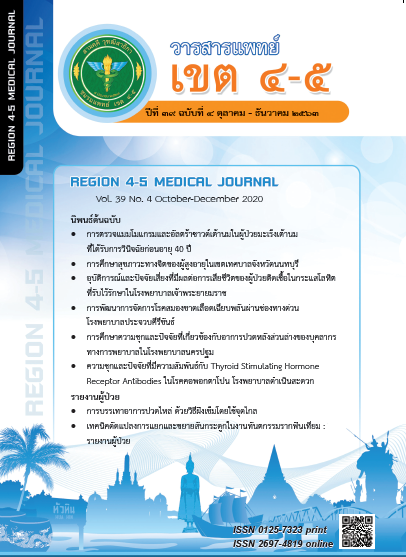ปัจจัยที่มีผลต่อการมีเลือดออกในสมองสำหรับผู้ป่วยหลอดเลือดสมองอุดตันที่ได้รับยา rtPA
คำสำคัญ:
ปัจจัย, โรคหลอดเลือดสมองอุดตันเฉียบพลัน, ยาละลายลิ่มเลือด, เลือดออกในสมองบทคัดย่อ
บทคัดย่อ
โรคหลอดเลือดสมองอุดตันเฉียบพลันเป็นเป็นโรคทีมีอัตราการเสียชีวิตร้อยละ 62.6 การรักษาคือการให้ยาละลายลิ่มเลือด recombinant tissue plasminogen activator (rtPA) แต่การให้ยามีผลข้างเคียงที่สำคัญคือเลือดออกในสมองทำให้ผู้ป่วยมีอาการแย่ลงหรือเสียชีวิตได้ การทราบปัจจัยอันที่ส่งผลต่อการมีเลือดออกในสมอง จะช่วยให้สามารถวางแผนป้องกันและลดอัตราตายลงได้
วัตถุประสงค์: เพื่อหาปัจจัยที่มีผลต่อการมีเลือดออกในสมอง สำหรับผู้ป่วยหลอดเลือดสมองอุดตันเฉียบพลัน ภายหลังได้รับยา rtPA ในโรงพยาบาลราชบุรี
วิธีการศึกษา: เป็นการศึกษาย้อนหลัง ในผู้ป่วยที่เข้ารับการรักษาที่ห้องฉุกเฉิน โรงพยาบาลราชบุรี ที่เป็นโรคหลอดเลือดสมองอุดตันเฉียบพลันและได้รับยาละลายลิ่มเลือด rtPA ในช่วงตั้งแต่ 1 มกราคม พ.ศ. 2556จนถึง 31 ธันวาคม พ.ศ. 2562 โดยเก็บข้อมูลพื้นฐาน ข้อมูลทางคลินิก การมีเลือดออกในสมอง การตาย เพื่อหาปัจจัยที่เกี่ยวข้องกับการมีเลือดออกในสมอง
ผลการศึกษา: มีผู้ป่วยที่มารักษาด้วยโรคหลอดเลือดสมองอุดตันเฉียบพลันจำนวน 256 คน มีอยู่ 6 คนที่ไม่สามารถสืบค้นข้อมูลได้ มีเลือดออกในสมองจำนวน 37 คน คิดเป็นร้อยละ 14.8 ปัจจัยที่ผลต่อการมีเลือดออกในสมอง คือ ค่าคะแนน NIHSS ซึ่งในกลุ่มที่มีเลือดออกในสมองจะมีคะแนนที่สูงกว่าอย่างมีนัยสำคัญทางสถิติ 13(10.5-19.0) vs 10(7-15) p=.002 และเมื่อนำกลุ่มที่มีเลือดออกในสมองมาวิเคราะห์ พบว่า กลุ่มที่เสียชีวิตจะมีระดับความดันไดแอสโตลิกและระดับน้ำตาลที่สูงกว่ากลุ่มรอดชีวิต 104(18.66) vs 82.79(14.28) p=.001 และ165(119.00-257.50) vs 110.50(99.25-143.00) p=.015 ตามลำดับ
สรุป: ระดับคะแนน NIHSS เป็นปัจจัยที่มีผลด่อการมีเลือดออกในสมองในผู้ป่วยหลอดเลือดสมองอุดตันเฉียบพลันที่ได้รับยา rtPA
เอกสารอ้างอิง
1. Benjamin EJ, Muntner P, Alonso A, et al. Heart Disease and Stroke Statistics-2019 Update: A Report From the American Heart Association. Circulation. 2019; 139(10): e56-e528. doi: 10.1161/CIR.0000000000000659.
2. Powers WJ, Rabinstein AA, Ackerson T, et al. 2018 Guidelines for the Early Management of Patients With Acute Ischemic Stroke: A Guideline for Healthcare Professionals From the American Heart Association/American Stroke Association. Stroke. 2018; 49(3): e46-e110. doi: 10.1161/STR.0000000000000158.
3. Atlantis T, Study PA, Investigators G. Association of outcome with early stroke treatment: Pooled analysis of ATLANTIS, ECASS, and NINDS rt-PA stroke trials. Lancet. 2004; 363(9411) :768–74. doi: 10.1016/S0140-6736(04)15692-4.
4. Wardlaw JM, Murray V, Berge E, et al. Recombinant tissue plasminogen activator for acute ischaemic stroke: An updated systematic review and meta-analysis. Lancet. 2012; 379(9834): 2364–72. doi: 10.1016/S0140-6736(12)60738-7.
5. Yaghi S, Willey JZ, Cucchiara B, et al. Treatment and outcome of hemorrhagic transformation after intravenous alteplase in acute ischemic stroke a scientific statement for healthcare professionals from the American Heart Association/American Stroke Association. Stroke. 2017; 48(12): e343–61. doi: 10.1161/STR.0000000000000152.
6. Strbian D, Sairanen T, Meretoja A, et al. Patient outcomes from symptomatic intracerebral hemorrhage after stroke thrombolysis. Neurology. 2011; 77(4): 341–8. doi: 10.1212/WNL.0b013e3182267b8c.
7. Hacke W, Kaste M, Bluhmki E, et al. Thrombolysis with alteplase 3 to 4.5 hours after acute ischemic stroke. N Engl J Med. 2008; 359(13): 1317-29.
8. Adams HP, Davis PH, Leira EC, et al. Baseline NIH Stroke Scale score strongly predicts outcome after stroke: A report of the Trial of Org 10172 in Acute Stroke Treatment (TOAST). Neurology. 1999; 53(1): 126–31. doi: 10.1212/wnl.53.1.126.
9. Cucchiara B, Tanne D, Levine SR, et al. A Risk Score to Predict Intracranial Hemorrhage After Recombinant Tissue Plasminogen Activator for Acute Ischemic Stroke. J Stroke Cerebrovasc Dis. 2008; 17(6): 331–3. doi: 10.1016/j.jstrokecerebrovasdis.2008.03.012.
10. Lou M, Safdar A, Mehdiratta M, , et al. The HAT Score: A simple grading scale for predicting hemorrhage after thrombolysis. Neurology. 2008; 71(18): 1417–23. doi: 10.1212/01.wnl.0000330297.58334.dd.
11. Strbian D, Engelter S, Michel P, et al. Symptomatic intracranial hemorrhage after stroke thrombolysis: The SEDAN score. Ann Neurol. 2012; 71(5): 634–41. doi: 10.1002/ana.23546.
12. Mazya M, Egido JA, Ford GA, et al. Predicting the risk of symptomatic intracerebral hemorrhage in ischemic stroke treated with intravenous alteplase: Safe Implementation of Treatments in Stroke (SITS) symptomatic intracerebral hemorrhage risk score. Stroke. 2012; 43(6): 1524–31. doi: 10.1161/STROKEAHA.111.644815.
13. Menon BK, Saver JL, Prabhakaran S, et al. Risk score for intracranial hemorrhage in patients with acute ischemic stroke treated with intravenous tissue-type plasminogen activator. Stroke. 2012; 43(9): 2293–9. doi: 10.1161/STROKEAHA.112.660415.
14. Flint AC, Cullen SP, Faigeles BS, et al. Predicting long-term outcome after endovascular stroke treatment: The totaled health risks in vascular events score. Am J Neuroradiol. 2010; 31(7): 1192–6. doi: 10.3174/ajnr.A2050.
15. Saposnik G, Guzik AK, Reeves M, et al. Stroke Prognostication using Age and NIH Stroke Scale: SPAN-100. Neurology. 2013; 80(1): 21–8. Doi: 10.1212/WNL.0b013e31827b1ace.
16. Strbian D, Meretoja A, Ahlhelm FJ, et al. Predicting outcome of IV thrombolysis - Treated ischemic stroke patients: The DRAGON score. Neurology. 2012; 78(6): 427–32. doi: 10.1212/WNL.0b013e318245d2a9.
17. Guo Y, Yang Y, Zhou M, et al. Risk factors of haemorrhagic transformation for acute ischaemic stroke in Chinese patients receiving intravenous recombinant tissue plasminogen activator: A systematic review and meta-analysis. Stroke Vasc Neurol. 2018; 3(4): 203–8. Doi : 10.1136/svn-2018-000141.
18. Fonarow GC, Smith EE, Saver JL, et al. Timeliness of tissue-type plasminogen activator therapy in acute ischemic stroke: patient characteristics, hospital factors, and outcomes associated with door-to-needle times within 60 minutes. Circulation. 2011; 123(7): 750–8. doi: 10.1161/CIRCULATIONAHA.110.974675.
19. Liu M, Pan Y, Zhou L, et al. Predictors of post-thrombolysis symptomatic intracranial hemorrhage in Chinese patients with acute ischemic stroke. 2017 ;12(9):e0184646. Doi: 10.1371/journal.pone.0184646.
20. Suankool S, Lokeskrawee T. Factors affecting Intracerebral Hemorrhage following Intravenous Thrombolysis in Patient with Acute Ischemic Stroke. Lampang Medical Journal. 2016; 37(2): 67–77.
21. Phankhian P. Factors Affecting the Occurence of Intracerebral Hemorrhage After Intravenous Recombinant Tissue Plasminogen Activator Therapy. Region 4-5 Medical Journal. 2015; 34(2): 120–30.
22.Enderlein G. Daniel, Wayne W.: Biostatistics — A Foundations for Analysis in the Health Sciences. Wiley & Sons, New York—Chichester—Brisbane—Toronto—Singapore, 6th ed. 1995, 780 S., £58.—, ISBN 0–471–58852-0 (cloth). Biometrical J. 1995; 37(6).
23. Guo Y, Yang Y, Zhou M, et al. Risk factors of haemorrhagic transformation for acute ischaemic stroke in Chinese patients receiving intravenous recombinant tissue plasminogen activator: a systematic review and meta-analysis. Stroke and Vascular Neurology 2018; 3: e000141.
24. Fiorelli M, Bastianello S, Kummer RV, et al. Hemorrhagic Transformation Within 36 Hours of a Cerebral Infarct. Stroke 1999; 30(11): 2280-4. Doi: 10.1161/01.str.30.11.2280.
25. Berger C, Fiorelli M, Steineret T, et al. Hemorrhagic Transformation of Ischemic Brain Tissue. Stroke. 2001; 32(6): 1330-5. DOI: 10.1161/01.str.32.6.1330.
ดาวน์โหลด
เผยแพร่แล้ว
รูปแบบการอ้างอิง
ฉบับ
ประเภทบทความ
สัญญาอนุญาต
ลิขสิทธิ์บทความเป็นของผู้เขียนบทความ แต่หากผลงานของท่านได้รับการพิจารณาตีพิมพ์ลงวารสารแพทย์เขต 4-5 จะคงไว้ซึ่งสิทธิ์ในการตีพิมพ์ครั้งแรกด้วยเหตุที่บทความจะปรากฎในวารสารที่เข้าถึงได้ จึงอนุญาตให้นำบทความในวารสารไปใช้ประโยชน์ได้ในเชิงวิชาการโดยจำเป็นต้องมีการอ้างอิงถึงชื่อวารสารอย่างถูกต้อง แต่ไม่อนุญาตให้นำไปใช้ในเชิงพาณิชย์




